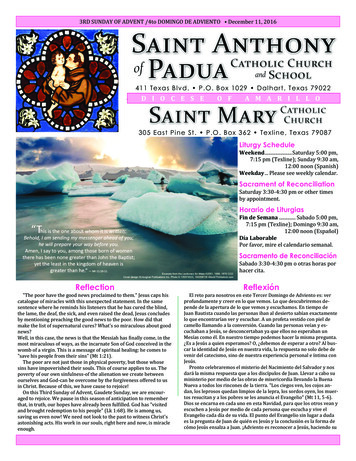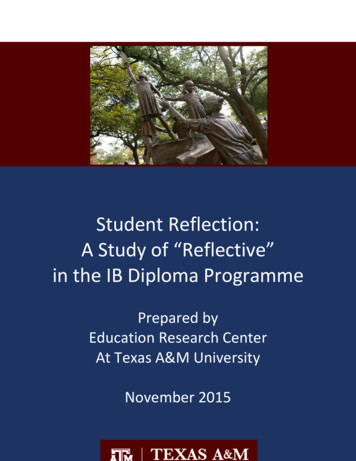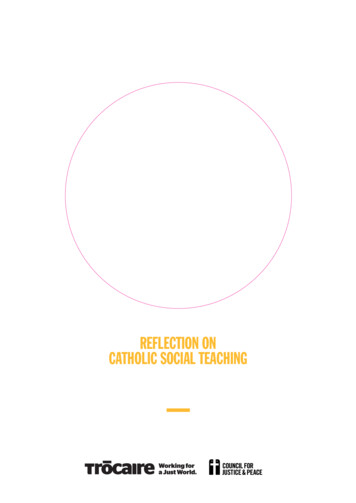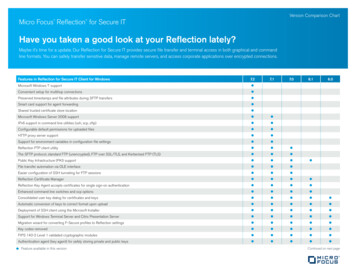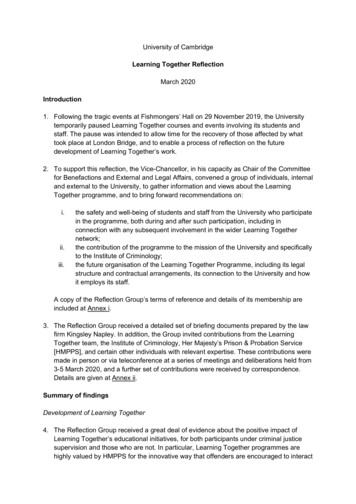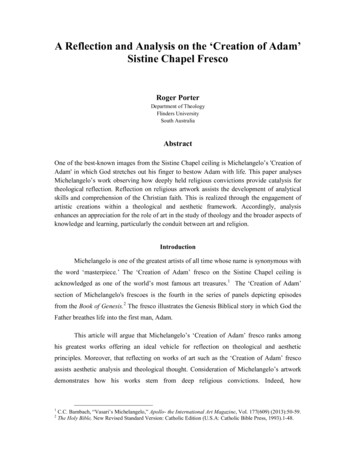
Transcription
A Reflection and Analysis on the ‘Creation of Adam’Sistine Chapel FrescoRoger PorterDepartment of TheologyFlinders UniversitySouth AustraliaAbstractOne of the best-known images from the Sistine Chapel ceiling is Michelangelo’s 'Creation ofAdam' in which God stretches out his finger to bestow Adam with life. This paper analysesMichelangelo’s work observing how deeply held religious convictions provide catalysis fortheological reflection. Reflection on religious artwork assists the development of analyticalskills and comprehension of the Christian faith. This is realized through the engagement ofartistic creations within a theological and aesthetic framework. Accordingly, analysisenhances an appreciation for the role of art in the study of theology and the broader aspects ofknowledge and learning, particularly the conduit between art and religion.IntroductionMichelangelo is one of the greatest artists of all time whose name is synonymous withthe word ‘masterpiece.’ The ‘Creation of Adam’ fresco on the Sistine Chapel ceiling isacknowledged as one of the world’s most famous art treasures.1 The ‘Creation of Adam’section of Michelangelo's frescoes is the fourth in the series of panels depicting episodesfrom the Book of Genesis.2 The fresco illustrates the Genesis Biblical story in which God theFather breathes life into the first man, Adam.This article will argue that Michelangelo’s ‘Creation of Adam’ fresco ranks amonghis greatest works offering an ideal vehicle for reflection on theological and aestheticprinciples. Moreover, that reflecting on works of art such as the ‘Creation of Adam’ frescoassists aesthetic analysis and theological thought. Consideration of Michelangelo’s artworkdemonstrates how his works stem from deep religious convictions. Indeed, how12C.C. Bambach, “Vasari’s Michelangelo,” Apollo- the International Art Magazine, Vol. 177(609) (2013):50-59.The Holy Bible, New Revised Standard Version: Catholic Edition (U.S.A: Catholic Bible Press, 1993).1-48.
2Michelangelo’s frescos offer theological insights when mindful of the interrelated roles ofAdam and the Father (Genesis 2:19, 21, 23; 3:8-9, 17).3Accordingly, four aspects of Michelangelo’s life will be dealt with here, namely: (1) abrief biography of Michelangelo, (2) a history of the Sistine Chapel, (3) a description of the‘Creation of Adam’ fresco, and (4) a reflection on the fresco.A Brief Biography of MichelangeloMichelangelo di Lodovico Buonarroti Simoni, commonly known as Michelangelo,was born on March 6, 1475 at Caprese, Tuscany (Italy). Michelangelo was a renownedFlorentine sculptor, painter, architect, poet, and founder of the high Renaissance style and themost influential of late Renaissance artists.4 As an artist Michelangelo was the creator ofworks of magnificent transcendence that conveyed the fullness of the human condition.However, in circles where art prospered only with patronage, Michelangelo was trapped amidthe differing powers and caprices of the Medici family in Florence and the Papacy in Rome.Distinct from many artists of his time, his brilliance was acknowledged, but at great cost tohis personal life.5Michelangelo’s career spanned 70 years, over which time he was the pivotal characterin Italian art. Michelangelo’s lineage was from a poor yet aristocratic father claiming nobleancestry. This was a thorny issue for Michelangelo as his family’s opposition to an artisticcareer stemmed from such pride of birth, and was accentuated by Michelangelo's claim on thestatus of painting and sculpture as ranking among the higher liberal arts.6Michelangelo’s father, despite his opposition to his son’s artistic ambitions,apprenticed him to the painter Ghirlandaio in 1488.7 This association brought Michelangelounder the influence of Lorenzo de’ Medici and progressive artistic-philosophic trends.However, privately, Michelangelo’s works and texts revealed a deep, enduring Catholic pietyand his art personified a notion and vision of human dignity and reliance on the Creator.83The Holy Bible, NRSV Catholic Edition, 2-3.Kleetus K. Varghese, Michelangelo and the Human Dignity : An Anthropological Reading of the SistineFrescoes (Bangalore: Asian Trading Corp., 2005), 31-35.5Enrica Crispino, Michelangelo, 1st ed., Artist's Life (Firenze: Giunti, 2001), 8-10.6Patrick J. Ryan, “The Right and the Left,” America, Vol. 169 Issue 15 (11/13/1993): 23-23.7Richard Viladesau, The Triumph of the Cross : The Passion of Christ in Theology and the Arts from theRenaissance to the Counter-Reformation (New York ; Oxford: Oxford University Press, 2008),47.8F. Hartt, The New Catholic Encyclopedia 2nd edition (U.S.A.: Thomson Gale, 2003), 601-603.4
3Accordingly, Michelangelo was completely committed to art and religion, livingfrugally despite his fame. He was the subject of two detailed biographies in his lifetime, bothby close associates (Vasari and Condivi). More is known about Michelangelo’s personalqualities and career than any previous artist.9 Michelangelo was aware of his worth and hisplace in the world, despite his scornfulness of society and the trappings of success.Personally, he was affectionate and generous to his family and friends yet inclined to bedistrustful and withdrawn harbouring a sharp temper and a sarcastic tongue. However, asByrne and Houlden note: “With a celebrated artist like Michelangelo, it becomes clear thatthe very person of the artistic creator can at times embody and signify spiritual valuestranscending matters of mere personality.”10Furthermore, as Emison states relative to Vasari’s view of Michelangelo’s standing inhistory:Michelangelo was sent by a merciful God, to be for us a spirit who, workingalone, was able to demonstrate in every art and every profession the meaning ofperfection in the art of design, how to give relief to the details in paintings bymeans of proper drawing, tracing, shading, and casting light, how to work withgood judgement in sculpture, and how to make buildings comfortable andsecure, healthy, cheerful, well proportioned, and richly adorned with variousdecorations in architecture. Moreover, he wanted to join to this spirit true moralphilosophy and the gift of sweet poetry, so that the world would admire andprefer him for the wholly singular example of his life, his work, the holiness ofhis habits, and all his human undertakings, so that we would call him somethingdivine [heavenly] rather than mortal.11Historically, Michelangelo is viewed as an archetype Renaissance character due to theextraordinary order and flexibility in the disciplines he undertook. Michelangelo, togetherwith Leonardo da Vinci, is the best-documented artist of the 16th century and as noted byHarris, “Michelangelo remains the archetypal genius.”12 The most noteworthy ofMichelangelo’s art is considered to be his Sistine Chapel works in Rome. Specifically, scenesfrom Genesis and the ‘Creation of Adam’ on the Sistine Chapel ceiling together with TheLast Judgment on the altar wall add testament to this claim of genius.9Giorgio Vasari, Julia Conaway Bondanella, and Peter E. Bondanella, The Lives of the Artists, Oxford World'sClassics (Oxford: Oxford University Press, 1998), 479.10J. L. Houlden and Peter Byrne, Companion Encyclopedia of Theology, Routledge Reference (London:Routledge, 1995), 327.11Patricia A. Emison, Creating the "Divine" Artist : From Dante to Michelangelo, Cultures, Beliefs, andTraditions, (Leiden: Brill, 2004), 3.12Jonathan Harris, Art History : The Key Concepts, Routledge Key Guides (London: Routledge, 2006), 130.
4A History of the Sistine ChapelThe Sistine Chapel ceiling forms part of the large Papal Chapel built within theVatican by Pope Sixtus IV after which it is named.13 Michelangelo painted the Sistine Chapelceiling, between 1508 and 1512 at the commission of Pope Julius II, and in doing so createdone of the most renowned artworks of the High Renaissance.14 As Williamson points out,“The interior of St Peter’s, as we see it now, is the product of the 16th-century rebuildingprogramme, under Bramante and Michelangelo, which completely replaced the medievalbasilica.”15 Relative to the ceiling and particularly the passion of Christ, Viladesau notes, “Inthe ceiling of the Sistine Chapel (1508–12) the passion of Christ is not depicted, but it iseluded to symbolically through Old Testament prefigurings.”16Furthermore, the Murrays’ refer to this period in Michelangelo’s’ life by highlightingthat:The most outstanding painting of the first part of his life, from 1508 to 1512, isthe vault of the Sistine Chapel in the Vatican. In it are set out in images ofunforgettable imaginative power the history of the world from the Creation tothe Sacrifice of Noah after the Flood, in a sequence of four large and fivesmaller panels, together with the vividly characterized figures of the Messiah.17The appointment of Michelangelo to paint the Sistine Chapel arose from the receipt ofa letter from Pope Julius II. The letter revealed that the idea for finishing Sixtus IV’s Chapelhad been proposed when Michelangelo was previously in Rome. Michelangelo’s responsewas negative for he doubted his ability to paint the Chapel as required. However, on May 10,1508 Michelangelo contracted to paint the ceiling for 3,000 ducats and began workimmediately.Thereafter, Michelangelo worked on the ceiling daily over the following four years. Itproved to be harrowing and taxing labour, as Michelangelo had to climb scaffolding daily13Richard McBrien, The Pocket Guide to the Popes (New York: Harper Collins, 2006), 245.Ibid.,.25115Beth Williamson, Christian Art : A Very Short Introduction, Very Short Introductions (Oxford: OxfordUniversity Press, 2004),77.16Richard Viladesau, The Triumph of the Cross : The Passion of Christ in Theology and the Arts from theRenaissance to the Counter-Reformation (New York: Oxford University Press,2008), 233.17Peter Murray and Linda Murray, The Oxford Companion to Christian Art and Architecture (Oxford: OxfordUniversity Press, 1996), 323.14
5and lay flat on his back 65 feet above the floor with paint dripping down on him.18 Emisonaffirms this when stating, “The same Michelangelo who described himself as grotesquelymisshapen from painting the Sistine Ceiling.”19The ceiling's various painted elements form part of a larger scheme of decorationwithin the Chapel exemplifying much of the doctrine of the Catholic Church. These includethe large fresco of The Last Judgment on the sanctuary wall and the ‘Creation of Adam’ onthe ceiling, together with wall paintings by other highly regarded painters of the late 15thcentury such as Botticelli, Ghirlandaio and Perugino.20 Central to the ceiling decor are ninescenes from the Book of Genesis of which the ‘Creation of Adam’ is the best known, havingan iconic standing equalled only by Leonardo da Vinci's Mona Lisa (See Figures: 3-4). AsVarghese points out, “Every individual fresco in the ceiling is centred around nine centralpanels of which the ‘Creation of Adam’ is the central one.”21Due to the many centuries since Michelangelo’s initiating this work restoration wasnecessary due to degradation. The restoration of the Sistine Chapel frescoes was one of the20th century’s most momentous art renewals. Although the frescoes of the Sistine Chapel hadbeen restored previously, the aforementioned 20th century restoration was achieved betweenthe period of 1980 and 1994.22 This restoration was of particular significance due to the effecton art enthusiasts and historians. Colours and details were revealed for the first time incenturies. However, this extraordinary event was not without controversy, much of which hasbeen dispelled (critics claim that much Michelangelo’s original work was lost in the removalof various accretions).23A Description of the ‘Creation of Adam’ FrescoMichelangelo’s Sistine Chapel fresco of the ‘Creation of Adam’ (See figure: 1)occupies the first of three central ceiling panels of the Sistine Chapel known as ‘The Creationand Downfall of Adam and Eve’ frescos. The three panels in sequence are (1) ‘God Creates18James H. Beck, “Michelangelo's Sacrifice on the Sistine ceiling.” Renaissance Society and Culture (1991): 922.19Patricia A. Emison, Creating the "Divine" Artist : From Dante to Michelangelo, Cultures, Beliefs, andTraditions (Leiden: Brill, 2004), 173.20James Romaine, “Scripture on the Ceiling,” Christian History & Biography Issue 91 (Summer 2006): 22-26.21Varghese, Michelangelo and the Human Dignity, 333.22Jeffrey David, “The Sistine Restoration: a Renaissance for Michelangelo,” National Geographic 176 No. 6D(1989): 688-713.23James M. Wall, “Controversy over the Sistine Ceiling,” The Christian Century Vol. 104 Issue 24 (8/26/87 –9/2/87):708.
6Adam,’ (2) ‘The Creation of Eve’ and (3) ‘Adam and Eve are Tempted and Sent from Eden’(See Figure: 3)24. The three panels illuminate the Biblical story from the Book of Genesiswhere God the Father breathes life into the first man, Adam. These three panels were amongthe last frescoes to be finished as work on the ceiling neared completion.25In the ‘Creation of Adam’ fresco, God is portrayed as an old bearded man envelopedin a swirling cloak. Adam is entirely naked and positioned on the lower left.26 God’s rightarm is extended as if imparting the spark of life into Adam, whose left arm is extended in amirroring pose of God's.27 The mirroring pose suggests the underscoring of humanity’screation in God’s image. Notably, the fingers of Adam and God do not touch indicating thatGod, the giver of life, is reaching out to Adam with life.28 Relative to this notion, Pittalugapoints out:From the powerful hand of the Almighty, life and strength flow to the stilltender hand of the mortal and through his inert limbs. These limbs, moulded bythe vibrating light and shade and bounded by clear-cut contours, stand out as ifsculptured against the mountainside.29Moreover, much conjecture abounds about the significance of the ‘Creation of Adam’s’decidedly creative composition. M
1 C.C. Bambach, “Vasari’s Michelangelo,” Apollo- the International Art Magazine, Vol. 177(609) (2013) . Florentine sculptor, painter, architect, poet, and founder of the high Renaissance style and the most influential of late Renaissance artists.4 As an artist Michelangelo was the creator of works of magnificent transcendence that conveyed the fullness of the human condition. However .
